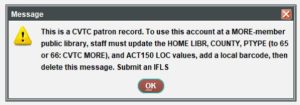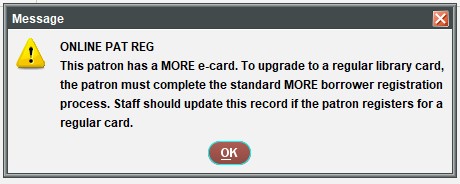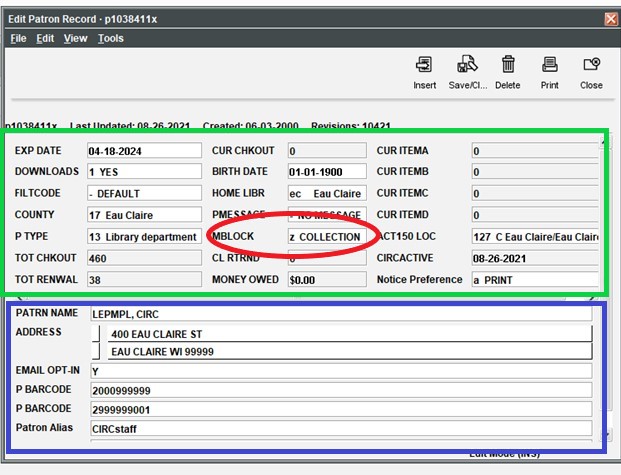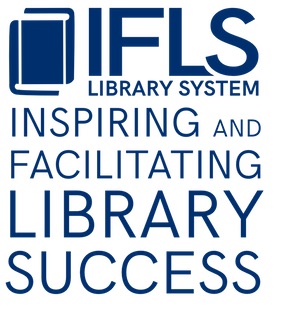Special Patron Records
CVTC Student and Employee records
CVTC and MORE video demo
Video note: MORE-member public libraries should also issue a local public library card to these patrons
CVTC student and employee data is used to create or update MORE patron records each week. This means CVTC students and employees:
- Have access to CVTC library resources and shared MORE resources upon enrollment
- Can visit a MORE-member public library to have their CVTC ONLY patron record upgraded to a CVTC MORE account. A CVTC MORE account:
- Allows the patron to check out materials from any MORE-member library, public or CVTC
- Allows access to shared electronic resources like Wisconsin’s Digital Library via Libby
If public library staff attempt to check items out to CVTC ONLY patrons, Sierra will show an error message that the patron “has exceeded the 0-item limit.” This, along with a message that “This is a CVTC patron record…” is a flag for public library staff to upgrade the CVTC ONLY account to a CVTC MORE account.
To upgrade to a CVTC MORE account, staff must update the existing CVTC ONLY patron record in Sierra:
- Search for the patron by name or CVTC ID number
- When opening the CVTC ONLY record in Sierra, this message appears:

- Change the fixed-field values at the top of the patron record as specified in the message:
- COUNTY: the patron’s county of residence
- PTYPE: to 65 – CVTC MORE Student or 66 – CVTC MORE Employee
- Home Library: to a MORE-member public library
- ACT 150 LOC: the patron’s city, village, or town of residence
- Issue a local library card:
- Leave the short CVTC ID (00+6 digits) in the existing barcode field
- Insert a second barcode field below the barcode field containing the CVTC ID with the public library card number
Notes:
- Primarily students and employees coded as “active” by CVTC will have patron records in MORE
- CVTC students and employees may have duplicate patron records, per MORE’s Patron Registration Policy. It is not necessary to check for, report, link, or delete duplicate records for CVTC patrons
- Patrons may use either their CVTC MORE patron record to check out at a MORE-member public library, or a previously-issued MORE-member public library account
- After a CVTC student or employee is coded as “inactive” by CVTC:
- CVTC ONLY patron records will be purged, unless there is associated library activity
- CVTC MORE patron records will be updated to MORE-member public library accounts, or merged with previously-issued MORE-member public library accounts
MORE E-card records
Patrons can register online for a MORE e-card, allowing access to MORE’s shared electronic resources. Upon submitting the registration form:
- Patrons receive a short barcode number on a confirmation screen and via email that can be used for accessing resources
- A new patron record is created in Sierra with patron type (PTYPE): 25, Online Patron Registration.
If a patron has a MORE e-card and wants to access physical library materials, the patron should complete your library’s standard MORE registration process/form, and staff should update the existing e-card patron record in Sierra.
- Search for the patron by name or e-card barcode number
- When opening the e-card record in Sierra, this message appears:

- Change some fixed-field values at the top of the existing e-card record to match what is usually entered for new patrons, and verify the information supplied online by the patron.
- EXP DATE: Enter your library’s standard future date here
- COUNTY: Verify
- P TYPE: Change to the standard Adult or Juvenile
- BIRTH DATE: Verify
- HOME LIBR: Change to your library, or the library the patron will use most often
- PMESSAGE: change to –
- MBLOCK: change to –
- ACT150 LOC: Use the one associated with their place of residence
- Notice Preference: From registration form
- Verify name, address, and email address
- Enter phone number if provided
- MESSAGE: remove
- P BARCODE: replace with a real, standard barcode
Durand student records
Durand Community Library has created MORE patron records for Durand-Arkansaw School District students who use the shared school/community library. These records contain minimal patron information. To check out MORE-member public library materials with these accounts, the patron should complete the standard registration process, and library staff should update the record fully (see fields to check in E-card section).
Patron records with MBLOCK = z
Accounts sent to a materials recovery service (“Collection”)
If a patron has at least one billed item and owes at least $25, some libraries send the account to a materials recovery service for follow-up billing. This service is currently used by Chippewa Falls, Eau Claire, and Menomonie based on the patron type (P TYPE) value in the patron record, and by Balsam Lake and Ladysmith based on the home library in the patron record.
Note that a “collection agency reporting charge” is added to these patron accounts, but submission to the materials recovery service does not adversely affect the patron’s credit score.
All customers who have been sent to “collection” will have a “Z” in the MBLOCK field of their account. NEVER remove this block. When the customer pays off their account, you may have to override this block to allow them to checkout but NEVER remove it.
It is removed overnight when the materials recover service is notified that the account was paid in full. If you remove the “Z”, the account will never be closed and the customer will still get mail from the materials recover service asking for payment.
Updating Accounts
In general, you may update the free text fields [blue square] of the customer’s account.
However, if you see a “Z” in the MBLOCK field [red circle], a good rule of thumb is you should not update the fixed fields [green square] in the customer’s account. The only exception to this would be to update the ACT 150 and COUNTY info if the address in the address field has changed. NEVER update the HOME LIB or the P TYPE.

Collecting Fines/Fees
For accounts at collections, the account balance must be paid to $0 (not under $10 as is true with accounts not at “collections”).
When a customer is at “collections” and is paying in increments, please apply payments in this order:
- Replacement fees: Fill out reimbursement slips for replacement fees as indicated by the owning location of the charged items
- Overdue fees
- “Collection agency” fees: Fill out reimbursement slips for the collection agency fees as indicated by the charge location UNLESS there is a message in the customer account indicating that the reimbursement should be sent elsewhere.
Paying the “collection agency” fee last will ensure that their account gets to the “paid in full” status if the customer pays in increments which will stop contact from the materials recover service. Partial payment is not allowed on the $10.00 “collection” fee. That must be paid in full.
